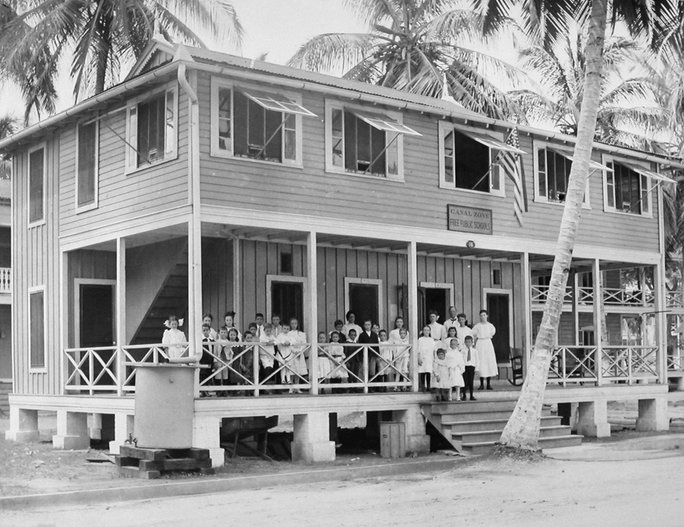“Zonians” refers to individuals who lived in the Panama Canal Zone, a U.S.-controlled territory from 1903 until 1979. The term encompasses various groups of people:
- American Citizens: Many Zonians were American citizens who lived and worked in the Canal Zone, including employees of the Panama Canal Company, their families, military personnel, and other U.S. government employees.
- Panamanians: Some Zonians were Panamanian citizens who worked or resided in the Canal Zone. They often commuted from surrounding areas or had specific roles within the Zone.
- Other Nationalities: The Canal Zone attracted workers from various countries due to its strategic importance and the employment opportunities it offered, resulting in a diverse community.
Well, let’s dive in:
- The Panama Canal Zone: Established in 1903, the Canal Zone was a narrow strip of land running alongside the Panama Canal. It was controlled by the United States and served as a hub for maintaining and operating the canal—a true engineering marvel.
- Life in the Zone: For Zonians, life in the Canal Zone was like living in a parallel universe. Imagine a tropical oasis where palm trees swayed, parrots squawked, and monkeys swung from branches. They enjoyed the beautiful Panamanian weather while nestled in comfortable American-style housing. It was like a small slice of the U.S. transplanted into Central America.
- Perks and Quirks: Zonians had it good. Generous benefits included subsidized housing, ample vacation time, well-stocked commissaries, and attentive staff. They had their own social clubs, sports teams, and even cinemas playing American releases. And yes, they could get away with not learning Spanish—English was the lingua franca.
- The Light Bulb Joke: How many Zonians does it take to change a light bulb? Two—one to call housing and the other to mix your drink! 🍹
- Segregation and Evolution: Now, it wasn’t all idyllic. For a long time, the Zone was segregated between American and Caribbean workers. Everything—from shops to latrines—was labeled as “gold” (for Americans) or “silver” (for West Indian and Caribbean workers). Over time, though, things evolved, and the Zone became more integrated.
- The End of an Era: Eventually, political changes led to the absorption of the Canal Zone into Panama. The Zonians dispersed, but their legacy remains—an intriguing chapter in the story of the Panama Canal.
Key Characteristics of Zonians
- Unique Identity: Zonians often developed a distinct cultural identity, shaped by the blending of American and Panamanian influences and the unique environment of the Canal Zone.
- Community and Lifestyle: Life in the Canal Zone was marked by a close-knit community with its own schools, services, and recreational activities, often separate from the rest of Panama.
- Bicultural Experience: Many Zonians had a bicultural experience, interacting with both American and Panamanian cultures, languages, and traditions.
Historical Context
- Treaties and Transfer of Control: The 1977 Torrijos-Carter Treaties set the stage for the transfer of control of the Canal Zone from the United States to Panama, a process completed in 1999. This transition marked the end of the Canal Zone as a U.S. territory.
- Legacy: The legacy of the Canal Zone and its inhabitants remains significant in the history of both Panama and the United States, influencing cultural, economic, and social aspects of the region.
Zonians hold a unique place in the history of Panama and the United States due to their role in the development and operation of the Panama Canal, a critical maritime route connecting the Atlantic and Pacific Oceans.
Panamanian Citizenship for Zonians
Requirements to obtain a Panamanian Cedula and Passport if you are a “zonian.”
- Be born in the former Panama Canal Zone between 1904 and 1979.
- Original of Birth Certificate (valid only for six months), issued by the U.S. Department of State. This document must be apostilled afterward
- Spanish translation of the birth certificate, issued by an authorized Panamanian translator
- Passport Copy
- Second identification, e.g., driver’s license
All documents must be presented to the Office of Foreign Registry and Judicial Acts at the Panama Civil Registry.
Regarding the Birth Certificate:
Between 1904 and 1979, the Government of the Canal Zone (managed by the U.S.) registered all civil acts, births, marriage, and death records. However, in 1979, the Commission of the Panama Canal Zone was responsible for all civil records of the Canal Zone.
The Commission ceased activities in December 1999. As a result, all civil records were transferred to the U.S. Department of State in Washington, D.C.
The following documents are necessary to obtain a birth certificate from the U.S. Department of State in Washington D.C.:
- Notarized letter requesting the birth certificate. This letter needs to include: full name at birth, any other names or aliases, date of birth, place of birth, the full name of the parents, current address, and phone number.
- Copy of a valid ID in the U.S.
- USD 50 Check, payable to the U.S. Department of State
All documents must be sent to:
U.S. Department of State
Passports Vital Records Section
44132 Mercure Cir.
PO Box 1213
Sterling, VA 20166-1213
